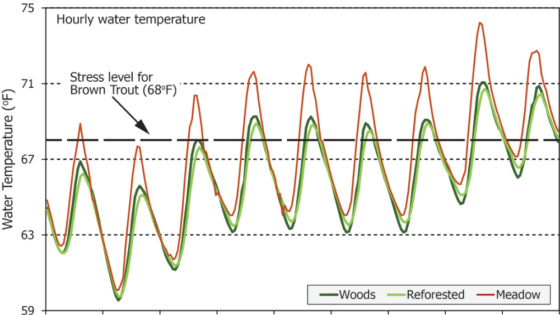Cover photo: Stroud Preserve by Nicholas Rohr
“Those who contemplate the beauty of the earth find reserves of strength that will endure as long as life lasts. … There is something infinitely healing in the repeated refrains of nature — the assurance that dawn comes after night, and spring after winter.” — Rachel Carson, Silent Spring
Writers, romantics, and nature lovers have long recognized the value of natural spaces to the mind and spirit. At Stroud Water Research Center, we’ve learned that open spaces, especially forests, help protect and restore clean fresh water. But as pressure toward development grows, governments increasingly need to weigh the benefits of protected open space against its costs. Is it possible to put a dollar value on open space, to show that money spent to preserve it is a wise investment in critical infrastructure?
Thanks to a new study in Chester County, Pennsylvania, Stroud Water Research Center’s home since 1967, we now know the answer is a resounding “yes.”
The Economic Benefits of Protected Open Space
The Return on Environment (RoE) study — a result of a partnership between Chester County Planning Commission, the Chester County Economic Development Council, the Chester County Association of Township Officials, and land conservancies active in the county — looked at five areas and found major economic benefits:
- Property value impacts: protected open space adds $1.65 billion to the value of Chester County housing stock.
- Environmental benefits: protected open space avoids $397 million in stormwater management capital costs, system maintenance, and pollutant removal costs.
- Recreation and health: protected open space provides $124 million in annual recreation benefits for residents and avoids $322 million in medical costs and lost productivity.
- Economic activity: protected open space generates $311 million in annual expenditures and salaries and $4.3 million in state and local tax revenues.
- Community cost savings: for every dollar in taxes received, farmland and open space require 7 cents worth of community services, compared to $1.11 for residential property.
Reversing the Misconception that Conserved Land is Unproductive
The RoE study offers a wealth of data that demonstrates how protected open space contributes to economic development and fiscal stability. Resources include the full study, the executive summary, and a downloadable brochure to share with your community.
Learn More
- Chester County voters overwhelmingly passed a $50 million bond referendum in 1989 for open space preservation. As of 2019, over 28% of Chester County’s land is preserved.
- The Department of Open Space Preservation can answer your questions about how to preserve a property for conservation or agricultural use.
- For more than 50 years, scientists at Stroud Water Research Center have demonstrated the connection between good land-use practices and clean fresh water.



